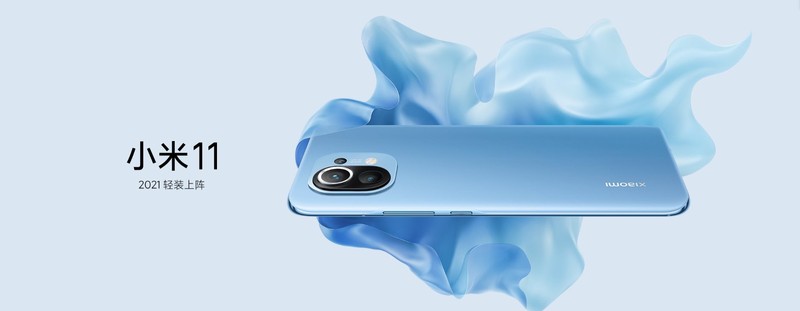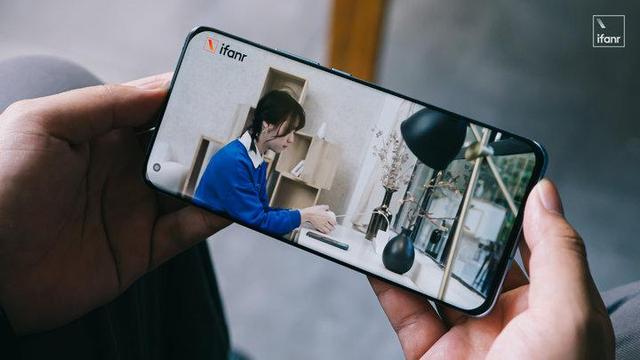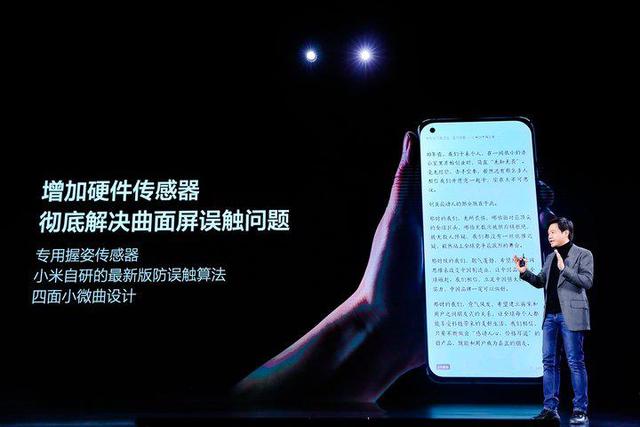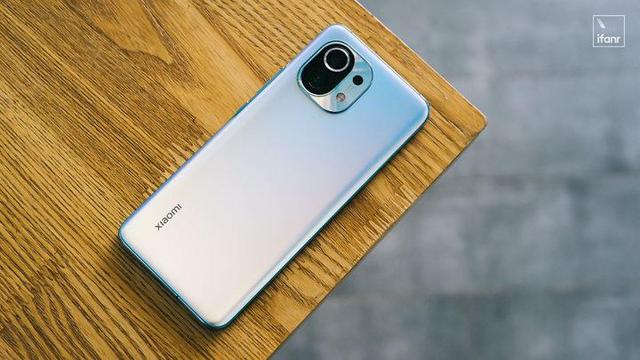
Xiaomi Mi 11 was released on December 28, 2020 at Xiaomi Technology Park. Xiaomi Mi 11 is the first mobile phone to use the Qualcomm Snapdragon 888 flagship processor. Xiaomi Mi 11 has a total of five colors this time. Among them, the AG frosted glass back shell is made of black, white and blue. In addition, there are two versions of smoke purple and khaki that are made of plain leather. BUY FROM AMAZON
Xiaomi Mi 11 Release Date:
December 28, 2020(Xiaomi Technology Park,Beijing)
Xiaomi Mi 11 Specs:
Xiaomi Mi 11 uses a 6.81-inch four-curved AMOLED screen with a resolution of 3200×1440, and supports 120Hz refresh rate and 480Hz touch sampling rate. This screen has an excitation brightness of 900nit and a peak brightness of 1500nit. In addition, it also supports primary color screens and 10bit color depth.
Xiaomi Mi 11 is first launched with the Snapdragon 888 processor. The Snapdragon 888 uses a 5nm process. Compared with the previous generation Snapdragon 865 processor, the overall CPU performance is increased by 25% and power consumption is reduced by 25%. GPU performance is improved by 35% and power consumption is reduced by 20%. Xiaomi Mi 11 also uses full-blood LPDDR5 memory, with a data transfer rate of up to 6400Mbps.
Xiaomi Mi 11 uses a 100-megapixel main camera, supports OIS optical image stabilization, and is equipped with a 13-megapixel ultra-wide-angle lens and a 5-megapixel telephoto macro lens. The main camera sensor is a 1/1.33 HMX, which supports four-in-one pixel technology. The front lens of the mobile phone is 20 million pixels and supports large wide-angle panoramic group photo mode.
In other respects, Xiaomi Mi 11 is equipped with a 4600mAh battery that supports 55W wired fast charging, 50W wireless fast charging and 10W reverse charging. It is worth mentioning that, in response to the call for environmental protection of science and technology, this time Xiaomi Mi 11 canceled the included charger. Xiaomi Mi 11 also uses X-axis linear motors and Harman Kardon tuning dual speakers, supporting multi-function NFC and infrared remote control.
Xiaomi Mi 11 Price:
The standard version of Mi 11 without charger and the package version with charger are priced at the same price, and will be officially launched on January 1.
8+128GB is priced at RMB 3999
8+256GB is priced at RMB 4299
12+256GB is priced at RMB 4699
Xiaomi Mi 11 Parameter
[table id=24 /]Xiaomi Mi 11 Review:
Although it seems to be on the last train of 2020, Xiaomi Mi 11 is essentially a flagship prepared for 2021. It also reflects the trend of flagship mobile phones in 2021 to a certain extent.
One obvious change is that the ability to take pictures is no longer the core ability of Mi 11, and the focus of effort has changed from taking pictures to screens. This is also a slightly weaker part of the Mi 10 series this year.
This is the best screen in Xiaomi’s history

The improvement of screen brightness comes from the upgrading of materials. Xiaomi Mi 11 is equipped with Samsung E4 material for the first time. The peak brightness of the screen has been pushed up again to 1500nits, and the global maximum brightness has also reached 900nits, whether it is from numbers or from the naked eye. Look, the screen of Mi 11 is brighter than the previous generation E3 material.
The 1080p resolution and 90Hz refresh rate on Mi 10 have been fully evolved on Mi 11. It is equipped with a 20:9 ratio, 6.81-inch four-curved OLED screen, this time it finally has a 2K resolution, the resolution is up to 3200×1440, the refresh rate has reached 120Hz, and it can be turned on together.
Other aspects such as 10bit color performance, better primary color calibration than before, touch sampling rate up to 480Hz, support for HDR10+ and other features, all indicate that this is the top screen on the market, even next year, it should not Fear of any opponent.

Many people can say that they love and hate curved screens, love its beauty, and hate it, which is easy to touch. This time, Xiaomi Mi 11 has added two hardware grip position recognizers. When it detects that you are holding the edge of the screen, the anti-incorrect touch area will shrink inward. According to the different horizontal and vertical lying positions, the shape of the anti-mistouch area will be automatically changed.
After simple actual measurement, the prevention of accidental touch is indeed improved, but it seems to be limited to the use of “streaking”.
Naturally, the power screen can’t just stay on the hardware. This time Xiaomi is also equipped with the AI master image quality engine, which has the flavor of the Xiaomi TV master series.
There are two new functions. The first is the SR super-resolution algorithm, which can “double” the resolution of low-resolution videos through the algorithm, and the other is the motion compensation function MEMC, which has been said for a long time. Mi 11 is integrated into the system.
These two functions theoretically support mainstream third-party video applications, but because the screen is too small and the algorithm requirements are high, the effect may not be obvious in daily use.
It is worth mentioning that Xiaomi also launched Corning Gorilla Glass Victus for the first time in China this time. The drop resistance is 1.5 times that of the previous generation, and the scratch resistance is twice that of the previous generation.
On the whole, the screen improvement of Xiaomi Mi 11 can be said to be huge, but there are some regrets. Although the power consumption of E4 material has dropped by 15%, this screen does not support LTPO in hardware, and does not support Dolby in function. Horizon.
In addition, due to the four curved surfaces, the R angle on the upper half of the screen is too large, and it seems that the screen is not aligned with the frame, which is a bit strange.
The screen piled up enough, and other places naturally didn’t fall. Full blood version of LPDDR5 memory, UFS 3.1 flash memory, better tuned X-axis linear motor, Wi-Fi6 enhanced version, VC liquid cooling, etc., it has everything the flagship should have.
Although the dual speakers of Mi 11 are changed to asymmetrical, the overall listening experience is more pleasant and comfortable.
The sound hole on the top of the phone is also engraved with the words Harman/Kardon, which means that Xiaomi has invited Harman’s Golden Ear team for tuning. The sound hole at the bottom shows the pattern of beating notes, and the overall refinement has increased.
In addition to the glass material version we have on hand, Xiaomi Mi 11 has also added two plain leather versions this time, obviously preparing to further establish the impression of high-end quality.
Is the Snapdragon 888 still stuck in “The Original God”?
Of course, there is the most important configuration, the first Qualcomm Snapdragon 888 processor.
Regarding Qualcomm’s next-generation flagship processor, although there have been many related reports, the so-called “final sense on paper”, the performance, power consumption, and heat generation of the Snapdragon 888 must be actually hand-held to see the truth.
Snapdragon 888 uses a 1+3+4 three-cluster architecture, which has a large core based on the X1 architecture, three based on the A78 core, and four small cores based on the A55 architecture.
To put it simply, compared with the A77 architecture of the Snapdragon 865, this brand new super core has increased its peak performance by 30%. Compared with the A77 core of the Snapdragon 865, the three A78 cores have optimized 50% power consumption. In terms of performance, the CPU part of the Snapdragon 888 has a 25% increase in overall performance and a 25% reduction in power consumption compared to the Snapdragon 865.
As for game performance, the new Adreno 660 has a 35% increase in performance and a 20% reduction in power consumption compared to the Adreno 650 used in the Snapdragon 865. It is also more stable to play some large-scale games with very high performance.
We also downloaded the AnTuTu benchmark and Geekbech 5 software to further test the performance of Snapdragon 888. According to the actual test results, AnTuTu’s running score exceeded 710,000, GeekBench’s single-core score was 1130, and the multi-core score was 3,725. Once again won the first place in the Android camp.
In order to actually experience the game performance of Snapdragon 888, we downloaded the recently popular mobile games “The Original God” and “Call of Duty”. And open all image quality and frame rate options to the highest test.
The actual measurement shows that the Snapdragon 888 performs well under the highest quality of the original god, most of the time is very smooth, but occasionally there will be wind. The performance of “Call of Duty” was very good, and there was no frame loss during the 30-minute game time. However, the large R corner of the screen will make some game elements incomplete, such as the Wi-Fi signal icon in the “Call of Duty” interface, which is mostly invisible.
As for heat dissipation, I have to say that the game “Original God” is very performance-intensive. The heat of the phone is quite obvious, and the upper part of the body feels hot to the touch.
We used a thermal imager for further testing and found that the heating area of Mi 11 is mainly concentrated in the area near the camera, and the highest temperature reached 42°-43°. It is better than iPhone 12 Pro Max, which reaches around 45-47°C.
It can be seen that the heat dissipation capacity of Xiaomi Mi 11 is still quite excellent. It not only uses the VC liquid-cooled three-dimensional heat dissipation system, but also has a new ultra-thin aerogel thermal blocking material built in to avoid the instantaneous accumulation of heat in local areas.
The charging head is “optional”, and the camera will continue to take 100 million pixels
In terms of charging speed, Mi 11 has been upgraded from Mi 10’s 30W to 55W, which also surpassed Mi 10 Pro, the big brother. It can be charged to 83% of electricity in 30 minutes, and it shows 100% in 46 minutes.
In addition, Xiaomi Mi 11 also has wireless charging and wireless reverse charging functions. The wireless charging power has been upgraded to 50W, which can be charged to 100% in 53 minutes. The wireless reverse charging is still 10W. Emergency charging and charging headphones are quite convenient.
Next, let’s talk about “environmental protection”. I have to say that Apple has really brought a wave of “environmental protection” this year. Yes, Xiaomi Mi 11 will not come with a charging head this time, and not only does it have no charging head, but also very Boldly even the data cable is also removed. But don’t rush to scold, Xiaomi is giving the user the right to choose this time. As long as you choose the “package version” when purchasing, you will be given a 55W GaN charger and data cable. If you have a surplus of charging heads at home, you can choose the “standard version”. There is no price difference between the two,
However, the charging head is still a Type-A interface. After Xiaomi’s “magic modification”, it supports the PD protocol, and can also charge thin and light notebooks.
The body is lighter and thinner, and the battery of Mi 11 has been slightly shrunk from Mi 10’s 4780mAh to 4600mAh. In addition, the screen resolution and refresh rate have also become higher, which makes people a little worried about battery life. The specific performance depends of course on actual measurement.

In the wifi environment, we set the screen brightness of the Mi 11 to 80%, the loudspeaker volume to 50%, and then a three-hour battery life test. During these three hours, we simulated users’ daily usage habits and performed operations such as brushing Weibo, listening to music, playing games, watching videos, and brushing vibrato.
After three hours, the remaining power is 62%, and the battery life is good, slightly better than the iPhone 12 we tested before. It can be seen that the 4600mAh battery will at least not be the shortcoming of Xiaomi 11.
Compared with the hard-stacked screen, the Mi 11 basically maintains the configuration of the Mi 10 in terms of camera, but has changed from a vertical design to a square stepped design. Regardless of beauty and ugliness, at least the recognition is there, and it avoids the possibility of fingers touching the camera when holding it.
The main camera is still Samsung HMX 100 million pixel sensor. The sub-photograph used a 13 million ultra-wide-angle lens, and the original two lenses suspected of “make up the number” were cut off and replaced with a 5 million pixel telephoto macro lens.
We have seen this camera on the K30 Pro standard version. Compared to practicality, it is very interesting and can be used for macro photography.
When the Mi 10 Extreme Commemorative Edition was launched in the middle of the year, Xiaomi mentioned that high pixels and large pixels are two paths that Xiaomi will take, so it is understandable to continue to use 100 million pixels.
We compared the main camera of Mi 11 and iPhone 12 Pro Max. From the proofs, facing Apple, a player who relies on computational photography and 12 million pixels to beat the world, Xiaomi 11’s 100 million pixels magnification is obviously superior in daytime resolution.
But in terms of HDR control and overall picture look and feel, Apple is still more pleasing.
We also compared Xiaomi Mi 11 with Xiaomi Mi 10. From the actual performance, Xiaomi Mi 11 did not show any significant improvement in image quality compared to Mi 10, but thanks to the more powerful ISP, Xiaomi Mi 11 has a 100 million pixels The imaging speed is still much faster than that of Mi 10, and it brings a new night scene video function to Mi 11.
Night scene video can greatly improve the screen brightness during night scene shooting, which is helpful for video shooting under extreme light sensitivity. However, in our actual test, the test version of the firmware (MIUI12.0.9) has certain bugs. We encountered the loss of dark details, crazy focus, poor anti-shake effect, etc. We hope that Xiaomi can fix these algorithm problems of the camera as soon as possible .
In addition to the above-mentioned functions, Mi 11 has added several more interesting gameplays this time.
For example, the fingerprint module has a newly added heart rate detection function, which can be opened in the health app. Just press your finger on the fingerprint module to detect it in real time, avoiding the trouble of touching the camera like other mobile phones.
Overall, Xiaomi Mi 11 is still playing the role of a high-end flagship goalkeeper, setting a new standard for the flagship in 2021, and the strength of the screen also allows us to see that Xiaomi’s next direction is to take the previous weaknesses a little bit. Completion.
It is the first time for Xiaomi to release two generations of the Mi Digital Series at the same time in a year. This also caused the subconsciously written “last year” to be deleted repeatedly when writing copy.
This is not only because the next-generation flagship processor Snapdragon 888 comes earlier than ever, but also because Xiaomi wants to take the lead in the world’s premiere so that it can occupy a more favorable position in the 2021 flagship battle.
What is rare is that it is 0.9mm thinner and 12g lighter after a comprehensive upgrade compared to Xiaomi Mi 10. It also complies with the Slogan that “load lightly”.
As for a more comprehensive and extreme experience, such as 120W charging, large pixel main camera and periscope telephoto, I am afraid that it will be left to the later Pro version and even higher-end versions. As the “Middle Cup” Xiaomi Mi 11 has exceeded expectations, what kind of experience can Xiaomi, which will show its full strength by then, bring?